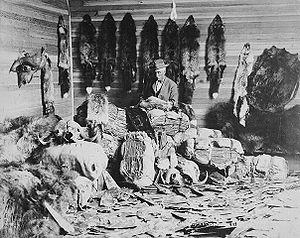Fur trade: Difference between revisions
fur trade in Russia |
|||
| Line 11: | Line 11: | ||
==Russian Fur Trade== |
==Russian Fur Trade== |
||
Befor the colonization of the Americas [[Russia]] was a major fur supplier of Western Europe and parts of Asia. Fur trade was a major Russian export since the early middle-ages. Originally majority of furs exported from Russia included pelts of [[martens]], beavers, wolfs, foxes, squirrels and hares. Between [[16th]] and [[18th]] centuries Russians tamed [[Siberia]] - region rich with various valuable kinds of fur-bearing animals such as [[arctic fox]],[[sable]], [[sea otter]] and [[stoat]]. In search of sea otter [[Russian Empire]] expanded into the Americas, notably [[Alaska]]. Between [[17th]] and the second half of the [[19th]] century Russia was the biggest fur-supplier in the world until [[USA]] and [[Canada]] joined the fur market. Fur Trade played a vital role in the development of Siberia, [[Russian Far East]] and [[Russian colonization of the Americas]]. To this day sable is a regional symbol in Siberian [Novosibirsk Oblast|Novosibirsk], [Tyumen Oblast|Tyumen] and [Irkutsk Oblast|Irkutsk] [[oblasts]]. |
Befor the colonization of the Americas [[Russia]] was a major fur supplier of Western Europe and parts of Asia. Fur trade was a major Russian export since the early middle-ages. Originally majority of furs exported from Russia included pelts of [[martens]], beavers, wolfs, foxes, squirrels and hares. Between [[16th]] and [[18th]] centuries Russians tamed [[Siberia]] - region rich with various valuable kinds of fur-bearing animals such as [[arctic fox]],[[sable]], [[sea otter]] and [[stoat]]. In search of sea otter [[Russian Empire]] expanded into the Americas, notably [[Alaska]]. Between [[17th]] and the second half of the [[19th]] century Russia was the biggest fur-supplier in the world until [[USA]] and [[Canada]] joined the fur market. Fur Trade played a vital role in the development of Siberia, [[Russian Far East]] and [[Russian colonization of the Americas]]. To this day sable is a regional symbol in Siberian [[Novosibirsk Oblast|Novosibirsk]], [[Tyumen Oblast|Tyumen]] and [[Irkutsk Oblast|Irkutsk]] [[oblasts]]. |
||
== See also== |
== See also== |
||
* [[Beaver Wars]] |
* [[Beaver Wars]] |
||
Revision as of 02:25, 12 November 2005
The fur trade (also called the Indian trade) was a huge part of the early history of contact in North America between European-Americans and American Indians (now often called Native Americans in the United States and First Nations in Canada). European traders and trappers explored the continent and established relationships with native communities, hoping to obtain the best pelts—beaver was especially prized—for European markets. Native hunters exchanged pelts for European-manufactured items that were desired in their communities, such as metal tools, firearms, clothing, and alcohol.

Often, the political benefits of the fur trade became more important than the economic aspects. Trade was a way to forge alliances and maintain good relations between different cultures. Consequently, there was much rivalry between different European-American governments for control of the fur trade with the various native societies. American Indian peoples sometimes based decisions on which side to support in time of war upon which side provided them with the best trade goods in an honest manner. Because trade was therefore so politically important, it was often heavily regulated in hopes (often futile) of preventing abuse. Unscrupulous traders sometimes cheated natives by plying them with alcohol during the transaction, which subsequently aroused resentment and often resulted in violence.
The fur trade came to a close as game was depleted by overhunting, as expanding European settlement displaced native communities from the best hunting grounds, and as European demand for furs subsided. In order to continue to obtain European goods and to pay off their debts, American Indians thereafter often resorted to selling land to the European settlers.
After the United States became independent, trading with Native Americans in the U.S. was nominally regulated by the Indian Intercourse Act, first passed on July 22, 1790. The Bureau of Indian Affairs issued licenses to trade in the Indian Territory, which in 1834 consisted of most of the United States west of the Mississippi River, where mountain men and traders from Mexico freely operated.
Russian Fur Trade
Befor the colonization of the Americas Russia was a major fur supplier of Western Europe and parts of Asia. Fur trade was a major Russian export since the early middle-ages. Originally majority of furs exported from Russia included pelts of martens, beavers, wolfs, foxes, squirrels and hares. Between 16th and 18th centuries Russians tamed Siberia - region rich with various valuable kinds of fur-bearing animals such as arctic fox,sable, sea otter and stoat. In search of sea otter Russian Empire expanded into the Americas, notably Alaska. Between 17th and the second half of the 19th century Russia was the biggest fur-supplier in the world until USA and Canada joined the fur market. Fur Trade played a vital role in the development of Siberia, Russian Far East and Russian colonization of the Americas. To this day sable is a regional symbol in Siberian Novosibirsk, Tyumen and Irkutsk oblasts.
See also
- Beaver Wars
- Dependency theory
- Grand Portage National Monument
- Hudson's Bay Company
- Dutch West India Company
- Northwest Company
- Mountain men
- Savanna Portage State Park
- Voyageurs
- Coureurs de bois
- Covenant Chain
- Pontiac's Rebellion
- Wampum
